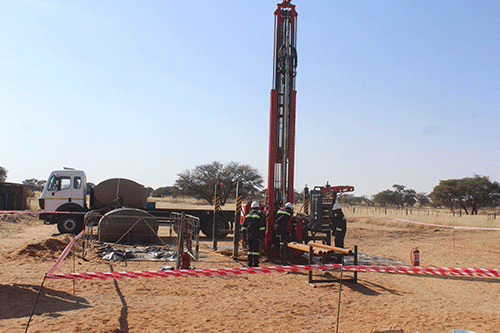A Russian company, Uranium One, exploring for uranium in the Omaheke region, continues to ruffle the feathers of local farmers. The company is expected to use the in-situ leaching (ISL) method to extract uranium.
ISL, also called in-situ recovery (ISR) or solution mining, is a mining process used to recover minerals such as copper and uranium through boreholes drilled into a deposit.
Uranium One Group is standing by its statement that all chemicals being used in its exploration activities are environmentally friendly, compared to conventional open-pit and underground mining; thus, farmers in the area should not be worried.
Farmers in the Leonardville area have been concerned of potential pollution with radioactive minerals about the underground water resource that covers the Stampriet Artesian Basin (SAB) aquifer, the largest artesian basin in the country, which covers 60 000 square kilometres in south-east Namibia, and it expands into neighbouring Botswana and South Africa.
The Stampriet Aquifer Uranium Mining Committee (SAUM), a committee of concerned farmers, geologists and other stakeholders, including lodge owners, who have been in contact with the Russian company, is not happy with Uranium One.
Farmers concern
The Stampriet Aquifer Uranium Mining Committee, under the tutelage of chairperson Divan Oppermann, last week warned that the future of all inhabitants of the Stampriet Artesian Basin is in jeopardy. This, he stated, is because mining operations could poison the freshwater source within these more than 63 000 square kilometres.
Oppermann added that the company is sugar-coating the dangers of radioactivity.
“Since in-situ leaching happens underground, no one can see the impact of this process immediately if leakage occurs. There is no guarantee that in-situ leach mining of uranium will not negatively affect our precious drinking water. We do not want to risk the health and safety of our children and of present and future generations, and endanger this unique and critical water resource,” he said in a statement released last month.
So far, about 600 exploration boreholes for uranium have been drilled in the basin.
SAUM noted that the aquifer water is also pumped by NamWater to supply the communities of Leonardville, Aranos, Aminius, Onderombapa, Derm, Stampriet, Gochas and Koes with drinking water.
Investment
Uranium One spokesperson Riaan van Rooyen stated to this paper that the 25-year Namibian project is anticipated to be of the same scale as one of the mines in Kazakhstan. Uranium One operates six in-situ recovery mines in Kazakhstan, which has a total yearly uranium production of 10 000 tonnes.
Upon the commencement of mining operations, Uranium One could invest between US$300 million to US$500 million in the domestic economy over 25 years.
And, according to the company’s project manager Kirill Egorov, Uranium One has already invested about US$50 million in the domestic economy. He also stressed that the company’s mining methods are environmentally-friendly.
When he visited the exploration site this
year, Omaheke governor Pijoo Nganate welcomed the exploration, saying it will help the region fight poverty through creating employment for locals.
Also, deputy mines minister Kornelia Shilunga urged the public to put trust in government, saying all steps had been followed and government is there to serve and not damage the community.
Namibian Uranium Institute
Executive director at the Namibian Uranium Institute Gabi Schneider, when asked her take on this technological mining method explained more than 50% of the world uranium production is mined by ISL methods, and most uranium mining in the USA, Kazakhstan and Uzbekistan is by ISL.ISL mining of uranium is also undertaken in Australia, China and Russia.
According to her, the USA, ISL is even seen as the most cost effective and environmentally acceptable method of mining.
“ISL involves leaving the ore where it is in the ground and recovering the minerals from it by dissolving them and pumping the pregnant solution to the surface where the minerals can be recovered. Consequently, there is little surface disturbance and no tailings or waste rock generated,” she said while responding to New Era questions.
She further explained: “Uranium ISL uses the groundwater in an orebody which is mixed with an agent that can dissolve the uranium. It is then pumped through the underground orebody to recover the minerals in it by leaching. Once the pregnant solution is returned to the surface, the uranium is recovered in much the same way as in any other uranium plant. Techniques for ISL have evolved to the point where it is a controllable, safe, and environmentally benign method of mining which operates under strict operational and regulatory controls.”
In Namibia’s Omaheke region, Schneider said the uranium ore bodies are found in the same geological environment as the Stampriet Artesian Aquifer, which requires a comprehensive environmental impact assessment, that is currently carried out.
On whether farmers should be worried, Schneider noted Namibia has very good environmental management legislation. It is exactly for that reason that the comprehensive environmental impact assessment is carried out. “Should farmers, however, still be worried, the environmental impact assessment procedure is the right process to raise any concerns or complaints,” she said.


